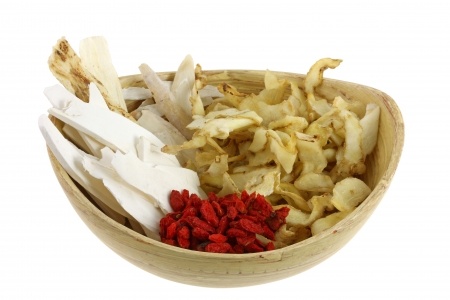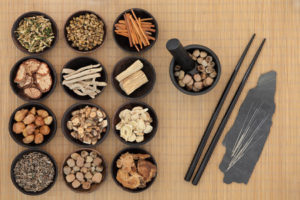An Introduction to Chinese Herbal Medicine
 Chinese Herbal Medicine has over 300 herbs that are commonly used today. The safety and effectiveness of these herbal formulas has been tested and refined over 2,000+ years of usage. Over 2 millennia, a vast amount of knowledge on these herbs has been accumulated in a search to perfect their clinical applications. According to a host of Chinese scientific studies, herbal medicine can greatly increase the effectiveness of Western drug treatments, reduce pharmaceutical side-effects, and sometimes replace Western medications completely. Many people are not aware that many modern drugs have been developed from herbs, such as treatments for asthma and hay fever from Chinese ephedra, hepatitis medications from schizandra fruits and licorice, and a large span of anticancer agents from trees and shrubs.
Chinese Herbal Medicine has over 300 herbs that are commonly used today. The safety and effectiveness of these herbal formulas has been tested and refined over 2,000+ years of usage. Over 2 millennia, a vast amount of knowledge on these herbs has been accumulated in a search to perfect their clinical applications. According to a host of Chinese scientific studies, herbal medicine can greatly increase the effectiveness of Western drug treatments, reduce pharmaceutical side-effects, and sometimes replace Western medications completely. Many people are not aware that many modern drugs have been developed from herbs, such as treatments for asthma and hay fever from Chinese ephedra, hepatitis medications from schizandra fruits and licorice, and a large span of anticancer agents from trees and shrubs.
The most common ways to take herbs are:
- Decoction – a strong tea that must be simmered for about an hour or more.
- Concentrated herbal powders.
- Prepared pills or “teapills”.
As the liquid decoctions are often too time-consuming to justify their use, and the powders are generally the preferred medium. Extracts powders are made by producing a large batch of tea and then reducing the water and producing a powder. The resulting powder is taken with water to make a tea.
The herbs used these preparations are generally harvested from wild supplies or cultivated farms, usually in China & Taiwan. There are as many as 5,000 herbal species in use, including nearly 1,000 materials derived from animal sources and over 100 minerals. Based on the plant itself, herbs are processed in a variety of ways. Each herb has a unique method of soaking, slicing, and drying, based on the methods that have been reported to be most useful. These materials are then combined in a formula and the ingredients and amounts of each herb depend on the person and the condition treated.
In practice, a practitioner of Chinese medicine constructs a specific formula for each individual patient. This formula may or may not be changed over a course of treatment. The outcome is monitored, and the determination of whether to continue the current formula, to change to another, or discontinue use is made on the basis of desired outcomes and effects of using the herbs.
Practitioners in the USA are trained at any one of about 50 colleges with a four-year series of courses that include Oriental medical theory, acupuncture, and herb prescription. Certification is offered at the national level and licensing or registration is offered now by most states. Many doctors from China have come to the U.S. and currently offer professional services throughout the country, but most often in the larger cities. Continuing education is provided through professional organizations devoted to Oriental medicine.
Following are some examples of common ingredients of Chinese formulas that have become widely used because of their reliable action, the quick results usually experienced, and the diversity of therapeutic activities that can be obtained from each.
COMMONLY-USED CHINESE HERBS
Astragalus (huang qi):
The long tap roots of astragalus are, today, the most commonly used herb material in China. Astragalus normalizes immune responses (used for immune deficiency, allergies, and autoimmunity), benefits digestive functions, and treats disorders of the skin from burns to carbuncles. Astragalus is used as a promoter of the functions of several other herbs, such as salvia and tang-kuei (mentioned below). It is used in the treatment of AIDS and hepatitis, for chronic colitis, senility, and cardiovascular diseases. Cancer patients who take this herb can often avoid the white blood cell deficiencies (leukopenia) that occur with chemotherapy. The root is rich in polysaccharides and flavonoids that produce the beneficial effects. Astragalus may be used by itself, usually as a liquid extract, or in combination with other herbs in the form of teas, pills, or tablets. Caution: some individuals may experience flatulence and abdominal bloating from use of astragalus.
 Atractylodes (bai zhu):
Atractylodes (bai zhu):
The rhizomes of atractylodes are considered very important to the treatment of digestive disorders and problems of water accumulation. The herb helps move moisture (and nutrients) from the digestive tract to the blood, reducing problems of diarrhea, gas, and bloating, and helps move moisture from the body tissues to the bladder for elimination, alleviating edema. The herb is frequently included in tonic prescriptions, and the herb is rarely used by itself. Caution: persons suffering from a hot and dry condition may experience worsening of those symptoms if large amounts of atractylodes are used.
Bupleurum (chai hu):
The thin roots of bupleurum are one of the most frequently used herbs in the Japanese practice of Oriental medicine. Doctors in Japan have found it useful in the treatment of liver diseases, skin ailments, arthritis, menopausal syndrome, withdrawal from corticosteroid use, nephritis, stress-induced ulcers, and mental disorders. The roots are rich in saponins that reduce inflammation and regulate hormone levels. The herb is not used by itself, but rather in formulas with about four to twelve ingredients, made as teas, pills, or tablets. Caution: some individuals may experience dizziness or headaches from use of bupleurum.
Cinnamon (rou gui):
The twigs (gui zhi) and bark (rou gui) of this large tropical tree are said to warm the body, invigorate the circulation, and harmonize the energy of the upper and lower body. Modern studies demonstrate that cinnamon reduces allergy reactions. Traditionally, cinnamon twig is used when the peripheral circulation is poor and cinnamon bark is used when the entire body is cold. If the upper body is warm and the lower body is cold, then cinnamon will correct the imbalance. Cinnamon is usually cooked together with other herbs to make a warming tea, or powdered with other herbs to make a pill or tablet that regulates circulation of blood. Caution: large amounts of cinnamon are irritating to the liver and should not be used by those with inflammatory liver disorders.
As you can see, each of these herbs has certain properties and should be used with caution. It is best to have a TCM practitioner create a formula for the best results and safety.
Get started with an herbal consultation today:
